Boxing questions on fighting styles, drills, making weight, conditioning, fighting Pacquiao & Mayweather, how to train with injuries, and more!
1. Which defense style is best for each type of opponent? – DKL
Shelled up (Arthur Abraham), Cross-arm (Joe Frazier, Gorege Foreman), Shoulder-roll (Mayweather), Peek-a-boo (Tyson). Can these be used in combination? Which is the best offensive plan for each?
- Very tricky question because every fighter has their own offensive and defensive stances. Some use the same stance for both whereas others will change around and even adapt their stances to their opponent.
- From the stances you gave above. I would use the Philly shell (Mayweather) against the shell defense (Abraham/Tyson). I consider Tyson’s “peek-a-boo” to be the same thing as Abraham’s but just a more offensive version. I would use the cross-arm defense against the Philly Shell.
 If you’re fighting a Philly shell fighter, try to get around his jab. Get behind his jab without being stuck under it. Throw lefts and rights around his left shoulder. If you’re fighting a shell defense fighter, just do it like Manny Pacquiao did against Clottey. Lots of quick punches and never let him get out of his shell. Stand sideways and make yourself really long so he can’t explode out of it and catch you with something big. If you’re fighting the cross-arm defense, you have to either over power him with blazing combinations or try to bait him into throw big shots so you can counter him. The cross-arm is the hardest to beat for my style of fighting, depending on how he holds his arms.
If you’re fighting a Philly shell fighter, try to get around his jab. Get behind his jab without being stuck under it. Throw lefts and rights around his left shoulder. If you’re fighting a shell defense fighter, just do it like Manny Pacquiao did against Clottey. Lots of quick punches and never let him get out of his shell. Stand sideways and make yourself really long so he can’t explode out of it and catch you with something big. If you’re fighting the cross-arm defense, you have to either over power him with blazing combinations or try to bait him into throw big shots so you can counter him. The cross-arm is the hardest to beat for my style of fighting, depending on how he holds his arms.
2. How can a southpaw throw a left hook? – Shawn
- If you aim it at the body, you can throw it like a left hook or left uppercut. If you’re aiming at the head, it will be more like an overhand left. Just throw a punch with the elbow bent and you will have your left hook. For good examples of southpaws throwing the left hook, watch Lucian Bute and Manny Pacquiao.
3. Do you know any specific drills to get inside? – Kamran
- Here’s the big tip: do aggressive DEFENSE drills. Have an opponent follow you around the ring with jabs as you try to slip and get CLOSER to him, not further. Also follow your trainer move around the ring running away from you throwing some punches as you slip and come CLOSER! Remember to practice aggressive defense in training. It also helps to have good footwork.
4. What is the falling step? – Sibtul
What is the falling step? I read about it Jack Dempsey’s book “Championship Fighting” but don’t understand it. It was said that a falling step generates a lot more power.
- The principle behind the falling step has been known for many years but often forgotten in many boxing gyms. The idea behind the falling step was simply to drop your body weight right as you punch, therefore adding the momentum of your falling weight into your punch. The falling step was Jack Dempsey’s method of dropping his body weight into the punch, which was to take a small step forward before the punch causing the body to drop downwards slightly. Jack Dempsey believed that landing the punch at the same time as the falling step would maximize the power in the punch.
- It is sound logic and 100% true but often forgotten about because amateur boxing is based on a scoring system. This means that the number of punches landed (quantity) is more important than the power behind the punches (quality). Generally, amateurs are in great shape and hit incredibly hard regardless of whether or not they drop their body weight into the punch. Their focus is on hitting and running, and not necessarily hitting with 100% power. I believe for that reason, this power technique is often forgotten about and not taught to boxers until they reach the professional ranks of boxing.
- By the way, this is a great question. I’m currently working on a guide to modernized and demonstrate other ways of utilizing the principles behind Jack Dempsey’s “falling step”.
5. What is a Mexican hook? – Sibtul
- A Mexican hook is the same as a hookercut. It’s a combination of a hook and an uppercut. It’s a hook with an upwards angle and usually aimed at the liver. It’s well-known for producing many beautiful body shot knockouts. The key thing is step in with the front leg and LEAVE YOUR BODY WEIGHT ON YOUR FRONT LEG when you throw it. Don’t transfer your body weight back to your back leg. (Or else you won’t be able to throw more than one HARD hook at a time.)
6. My joints hurt when I hit the heavy bag. What is wrong? – Leo
Hey Johnny, EVERY time I hit the bag my joints hurt like crazy the next day. Not my knuckles but the ones right above them. It’s always my left middle finger and now on my right pinky finger. I really don’t know what it is but maybe its the way my hands are inside the glove. I grab what feels like a little handle in the gloves, is this the problem? What should I do?
- If your hands are hurting, you’re either wrapping your hands incorrectly, hitting the bag incorrectly, or using a glove without good padding. I’m putting up a handwrapping video soon so be on the lookout for that. As for hitting the bag, try to land with your first 2 knuckles or with a straighter fist. Tightening your fist around the handle in the gloves is a good thing. That gives you a more solid fist. You might also be training too much on the heavy bag. Many pro’s don’t hit too hard anymore because of this problem. If your pinky finger is hurting, you’re definitely landing punches at a bad angle on your hand.
7. How would you fight against Manny Pacquiao? – Chris
- Assuming I am in the shape I am right now and using my own abilities, (because it would be foolish to imagine myself as some fighter that doesn’t exist), I would try to move sideways against Pacquiao and try to throw a counter after he throws 1 or 2 punches. Any time I feel 2 shots from him, I would immediately throw a 2-1-1. If he backs up, THANK THE LORD. If he’s still in range, I’d have to follow up with a 3-2-1-1 and run like hell. I would also try to lean back and see if he leans in with that overhand left. If he does, I’ll crack him with a right uppercut and push his head away with my left jab as I move around him.
- Realistically, he punches so fast that I’d spend the entire fight with my hands up like Joshua Clottey. I also don’t have the footwork energy required to run from him all day. AND he’s a southpaw, ugh!
8. How would you fight against Floyd Mayweather? – Chris
- Use a high guard and try to walk around his left hand. Attack with jabs and left uppercuts to his head while throwing straight rights at his body or head. (I want to pin down his left arm as I get around it.) If I can bait him to throw that long right hand, I’ll slip outside of it and dig to his body.
- Realistically, it would never work because Mayweather would throw the 1-3 combo all day long followed by a big right hand. Even if I block them, he’ll move after the right so I could never counter it.
9. How do I beat the bigger guys that keep swarming me? – Stefan
I am in Western Australia and I have been sparring some Mauri (native New Zealanders) boxers lately and they’re much bigger than me muscle/fat wise.
Most of them just swarm in on me and want to get me to the ropes, pressuring me. My style is more of a boxer/puncher and I weigh 75Kg.
My trainer tells me to hit or counter and then move all the time, but these big guys are not respecting or feeling the impact of my jab and it’s not fun to be running around the ring constantly.
The training ring is not huge so there is only so many steps I can take to move around. What can I do?
- How do you beat guys that are bigger than you? Ouch, it’s a tough problem to solve. If you don’t have the power to hurt them and don’t have the endurance to out-run them, that’s going to be a very hard case. I’ll do my best to recommend some tips that can overcome that deficit.
- If they like to lean on you, try to throw some wide hooks and pull down on their head. If they like to stand high, then you dip your head a little and bait them into throwing straights down at you. Once they throw the straights down at you, just stand up and punch them over the top.
- Instead of a jab, try to push at their face. Aim your glove right at the eye or the nose instead of the chin. When they get too close, push their head away! You can also try to bait their right hand. Stand still and block their jabs but move only when they attack with the right hand. When you run, keep going in and out, instead of straight out. You want to force their legs to keep stopping and going. This will tire out their legs faster. If you’re just running and they’re just walking, you’ll get tired easily.
- When you run, don’t just change directions for no reason. Keep running to your right when he jabs and don’t go left until after he throws a right hand. Then keep going to your left and don’t switch to your right under after he throws a left.
- When you punch, save your power. Turn down your power and throw 2-3 pitty pat shots to annoy them. (If you’re not hurting them anyway, why waste energy?) When they take that one giant swing, you backstep just a few inches. Save your energy for the running.
- Last but not least, size is a big advantage. Weight classes exist for a reason. It’s very hard to overcome size AND athleticism with just skills alone. At the very least, you will have to improve your physical ability as well.
10. When you box, what should you be thinking about? – DKL
I can’t figure out if I should be thinking about defending myself or throwing punches. It seems like the less I think, the better I do. If I go in there with a certain goal, I do well. Like, I’ll step in the ring and I’ll think to myself “Be busier”. And that’s it. Then when I do that, I do better it seems like. I’m less afraid.
When I start to think about specific’s like, “throw the jab out lightly to set up your big right hand” or “this guy looks like he can hit hard, so try to stay away from his power hand”, I’m too worried about getting knocked out, that I end up getting hit a lot anyway. If I try to think about setting something up, some combo or a power shot or something, I end up doing worse. Maybe you can do an article about this…
- Excellent question, DKL, because I am actually doing an article on this right now. Sparring is a time for learning, not winning. With that being said, boxers typically spar with the goal of working on specific things. I use sparring to practice new techniques. I don’t worry about winning a sparring match, I just want to practice the new techniques. You’re doing it right by just focusing on learning goals as opposed to trying to win the fight.
- It’s much better to lose a sparring match while practicing new techniques, than to win a sparring match using old techniques you already know.
11. How to lose weight before a fight? – Jerome
I have a fight in 3 weeks and I need to weigh less than I am now (84 to 81 kg) which is the healthiest way to lose weight in a short time?
- Yikes. Well, a solid diet is the best way to trim down healthy. Some guys would be wearing sauna suits and sweats all day, everyday. In the final 24 hours before the weigh-in is when you would be sitting in a sauna. You should also cut down on eating meat or anything heavy that take a long time to digest.
12. How long before an amateur fight should one stop having sex? – Angel
- If you were to ask any of my trainers this, they would have told you not to have sex even during training. If you’re asking me, I would tell you to figure out just how athletic you are and how much you care about the fight. I suggest you experiment for yourself and see how long out is ok. Scientifically, you should be fine if you do it the weekend before. If you truly trained hard 3 months for a fight and the fight is that important to you, then maybe you wouldn’t care to risk it.
13. What are some good old school training drills? – Javier
- Do you mean like old training methods from back in the day? Well there’s Nazim Richardson’s practice of swinging the towel at his fighters while they hit the heavy bag. I also remember one trainer making his boxers fight with their front foot stuck in a tire at center ring. Some learned how to slip whereas just got knocked out. Darn, I’m going to have to ask around for more old school drills. That would be a great article!
14. What is a good way to connect with the left hook? Body and head. – Javier
- Getting into hook range requires you to be closer to your opponent. It’s much easier to get him to come closer into you. Lean away from his punches and see if you can get him to lean into you. Once he does, you only have to slip his straight punches and you’ve got tons of opportunity for the left hook.
- Another way to connect with that left hook: throw it when your opponent throws the left hook. Trading can be a good idea at times and safer if you make sure to keep your right hand up. Many fighters are taught to pit their left hooks against their opponent’s right hands and that can be scary because the right hand easily beats a left hook. But if you exchange left hooks (with your right hand up), the worst case scenario is he blocks yours.
15. How can a taller boxer fight a shorter boxer without getting tired? – AMAN
- Don’t try to match his rhythm. Don’t take same number of steps or same number of punches. You have bigger steps and longer punches. Don’t try to counter him punch for punch. Take your time, control the distance and fight at your pace. Slow him down with better accuracy and power, don’t try to match his speed.
16. How to beat a shorter boxer? – AMAN
– I’ve released the guide here: How to Beat a Shorter Boxer
17. What is a good exercise to improve balance? – Jared
- I’ve been making a (balance) guide for this but here’s one of my favorite balance exercises. Standing on one leg, bend your knee to go down and touch your foot and then clap your hands above your head. Do it 15-20 times on one leg and then switch to the other leg. Do it over and over.
18. Do you have any weigh-in tips? – Paul
I’m wondering if you’ve got any weigh in tips? I box at 75kg and walk around at about 76kg when i weigh myself in the mornings, but this go’s up to 77ish during the day. I normally weigh in around 6pm, which means I have to get down to 74kg in the morning, and it can sometimes be a close call. It’s never happened, but I dread the day that I don’t make weight – all that hard work wasted. Can you offer any advice?
- I’m one of those guys that just stay trim and don’t fluctuate much in weight. If I need to weigh any less, I’ll skip breakfast or eat smaller meals the day before. I’m sorry I don’t have much personal experience in this department.
- It sounds like you’re doing a good job. My trainers will make sure that you stay within range and stay hydrated and then just sweat it all out in the morning in a sauna if need be. As long as you’re in range, you’ll be ok.
19. Would it be ok to do 9-minute rounds instead of doing 3-minute rounds? – Jesus
Would it be okay to instead of doing 3 or 4, 2-3 minute rounds of hitting a heavy bag do 3, 9 minute rounds. Would it be too much strain on your muscles because I do this 4 times a week? When we do roadwork we run continuously we don’t jog in intervals why cant we do that for sparring, and hitting a heavy bag I never got this? Please explain what’s best for a boxer.
P.S. I heard george foreman would hit a heavy bag for 15 minutes
- I’m not so worried about longer rounds being more straining on your muscles than shorter rounds. I just feel that it’s better to have your training mimic the rhythm of the fight. If the fight occurs at 3-minutes hard intensity and 1-minute rest, than it would be best to have your body train to that rhythm. If you go 9 minutes straight, there’s no way it would have the same intensity as if you took those breaks.
- By the way, there are boxers that run at 3min-1min intervals. In any case, running isn’t usually done in intervals because running is for increasing your cardio.
- George Foreman is a pro with a highly decorated amateur career, so he can train in whatever way he wants. For the rest of us normal folks, it’s safer to follow the science before we create our own personalized training routines.
20. How many miles should I run? – Anthony
I’m an amateur boxer. My fights are 3 rounds for 3 minutes.
- The minimum is 3 miles a day, 5 days a week, if you’re a competing fighter. I’ve heard of some boxers doing 3 miles a day, only 3 days a week but I wouldn’t recommend that.
21. How do I get fit like Bernard Hopkins? – bhop
Is there any way to get as fit as someone like Bernard Hopkins? He never gasses and is always in shape. Is there a way to get as fit as someone like him?
- There are so few Bernard Hopkins in the world, I wouldn’t know where to begin and how to analyze them. I have heard in many interviews that he trains and does something every single day. It may not be a hard workout but he’s always doing something. I think he’s done this for 20 years. So it’s gotten to the point where doing something athletic is just 2nd nature as walking. When I watch him fight, I can see that his fighting is very automatic. His opponents are fighting and panicing yet he’s always calm and never scared. It’s not that he isn’t fearless, it just seems like his body just knows what to do in all situations.
22. What is the difference between Mexican-style hand wraps and the traditional ones? Which do you prefer? – bhop
- The Mexican style handwraps are semi-elastic and have a little bit of stretch in them. They are much more comfortable and much better handwraps. Most boxers, including me, prefer the Mexican style. Some traditional ones that are made with really soft cotton and have at least a tiny bit of stretch are still ok.
23. I have a long reach and my arms tire quickly, what exercises can I do? – Anthony
- You need to do more shoulder endurance exercises. More speedbag work. When you punch at the heavy bag, aim higher at least at head level so your shoulders are activated into the exercise. Do tabata drills on the heavy bag, where you punch really fast for 15 seconds and then stop for 15 seconds, and repeat. It helps to do those with a partner. You can also do SLOW shadowboxing with light 2lb weights in each hand.
24. How often do you see hand/finger injuries in boxing? – Ev C
Can you give some recommendations on stretches and exercises for hand strength. I have been boxing for 2 years and recently have developed trigger finger at my knuckles on my left hand (where they click into a fist-it is not painful; just annoying). I know that you are not a doctor, but I was wondering if this is common in boxing and do you think I should hit a heavy bag?
- Hand injuries are always common in boxing. Your hand absorbs tremendous force through its small bones when you bang it against something day after day and you keep hitting harder as the weeks go by. The more experienced boxers do not hit the heavy bag so hard for that reason. I don’t know that injury is related to hand strength so much as it is related to hand abuse. I would suggest you lighten up on the heavy bag and only hit the bag every other day. You should also be landing your punches with a straight wrist, but I’m sure I you already know that.
25. What should I learn first? – Mike
I want to get into some serious boxing, I am 6’3″ 280 and I want it bad. What should I do first, my weight, stance, roadwork etc. I want to fight at 210 or 215. Is that lite or heavy. Thanks.
- For serious boxing, just get a trainer and do everything he says. Stance is the first thing you have to learn. Roadwork, conditioning, and getting in shape will be your everyday thing.
- Anything above 201 is “super heavyweight” by US amateur standards.
26. Are big punchers made or born? – bhop
- Both. Some punchers were born with natural punching mechanics. Others were trained. I’m not so sure I would prefer one over the other. Some boxers are trained so well you could never tell the difference. Some boxers are so natural that they can’t be trained to improve beyond their natural punching mechanics.
27. Could you possibly give me some tips on defense please? – David
When under a lot of pressure I either shell up or turn my shoulders and lean back to my right with my right hand in front of my face kinda like Floyd/Lights Out. It works usually but it doesn’t feel like the best position to counter-attack from and I feel like I need a few more alternatives.
- You’re definitely right, it’s very hard to counter-attack from that position. Instead of having your left fist wrapped around your belly, try holding that left hand wide out in front of you (dropped is ok). At least there you have a better chance to use it. Your opponent’s left hooks can still be blocked by your right elbow.
- Also if you have to lean back, try to pull your right foot back first so you always have a solid base to lean over. Otherwise you’ll keep falling off balance and be forced to give up ground. Lastly, try to find a way to be aggressive from that stance so that you’re not always forced into a defensive position when you’re using that stance. Practice that stance aggressively against smaller/slower opponents.
28. What are some good tactics for southpaws? – Tony
- I get asked this regularly so I’m going to come up with some new tactics from the usual. Here are 2 good ones to try:
- 1) Dip your head low and bait a downwards jab from your opponent. The moment he jabs down at your head, just pop up and whack him with an overhand left to the head. Follow up with a jab to the head and left to the body.
- 2) Lean back just a little bit and get him to throw a long jab at you. Try to get him to lean in at you. The moment he throws that long jab, tap his glove slightly with your right and throw your big left hand. It’s like you’re throwing a fast 1-2, but instead of a jab, you’re using the tap-block as your first “punch”. Don’t forget to follow-up with another 1-2 immediately afterwards.
29. Do you know any ways to weight train your legs without putting so much pressure on your knees? I’ve tried squats but can’t stand the strain on my knees. – Neal
- I would suggest the 45-degree leg press or the abductor and adductor machines. Perhaps you could degree the weight load and restrict the movement to only half the distance. On one set you do only the upper half, and on the next you do the lower half.
30. How effective is the title fast feet product and how should I use it? – Enrique
- The “fast feet” is good for beginners. You should use it when shadowboxing and when hitting the heavy bag. Once you get the hang of proper foot distance, you won’t need it anymore.





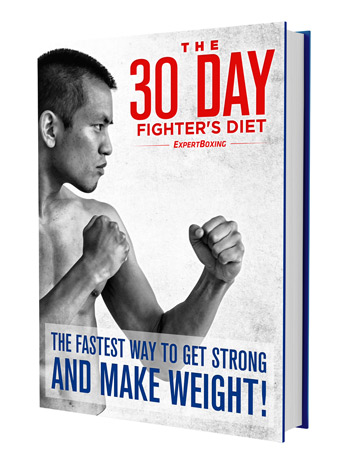
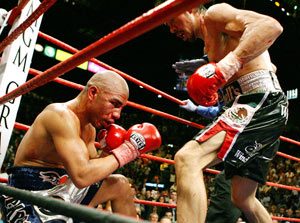
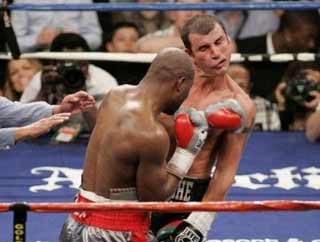
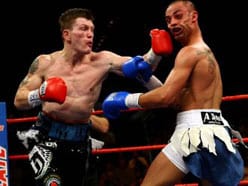
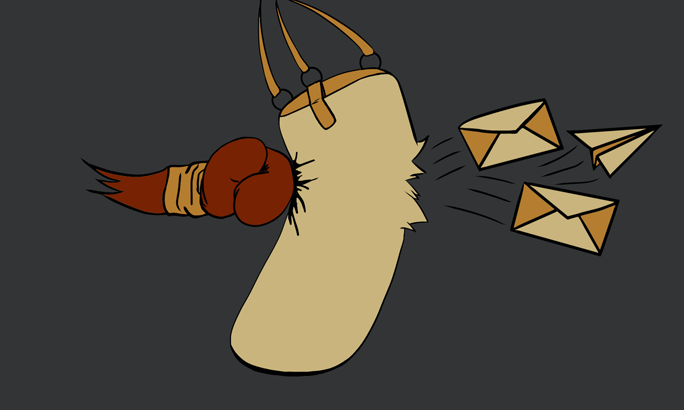
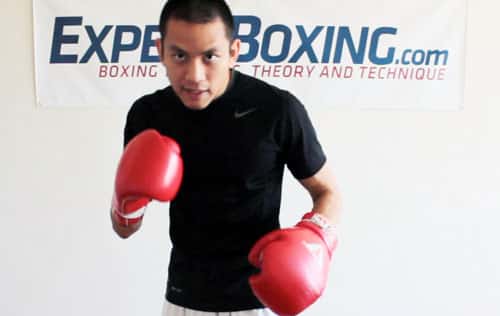
Aggressive defence
Thanks a lot for that, it is quite effective
Question #6
Yea, I do think its hitting it too hard for too long. I hit the bag for an hour and with all my might when I can. I guess I need to relax a bit. Thanks!
thanks like always your the best
Another great mailbag
Really look forward to these !
Great Job. Great Website.
🙂
Thanks, Alan!
As usual, great great tips. Thanks.
Nice and specific advice. I like the tips on sparring especially and its gotten so that I don’t dread sparring days anymore.
The staying in range & using angles strategy
Hey johnny its been a while since u talked about the drowning style which i appreciated your breaking it down, but u also said u were going to put up the other style of staying in range and using angles or being around the opponent without being hit much. I’m a small middleweight though i relish the fact too bcos of my speed, fight as southpaw & orthodox and a student of aaron pryor and pacquiao. So u see why i want to have a more definite feel on this style. Please post it in strategies or email [email protected] because by Gods grace u’ll be hearing about me soon.
Havent heard about you yet. Been 7 years lmao
@Ok, I wish you the best man! The other style guides are taking forever to write because well, there’s so much to write! But I won’t forget your request, don’t worry. Please hang on and take care in your career.
how will u box if the openent guy is height than u
Probably by having to come into range more and being faster/more defensive at times.